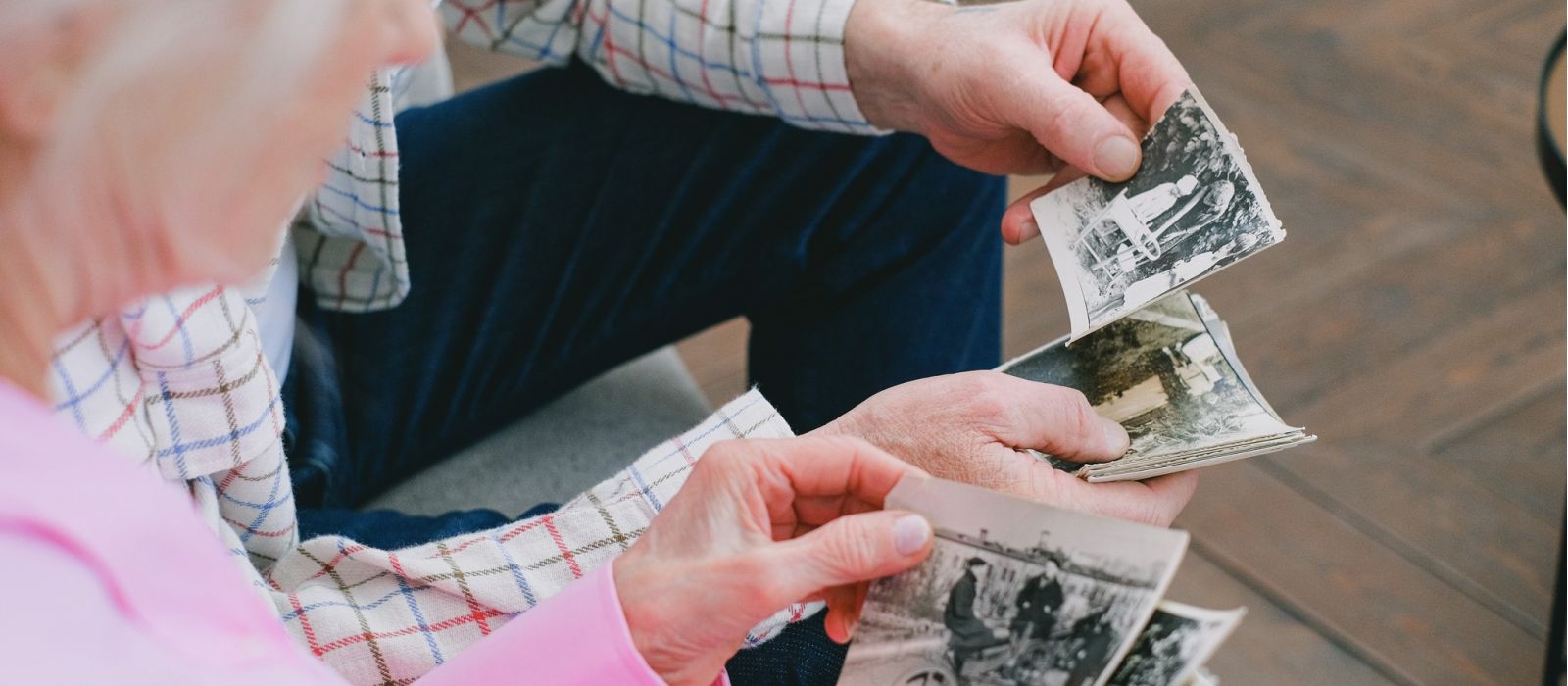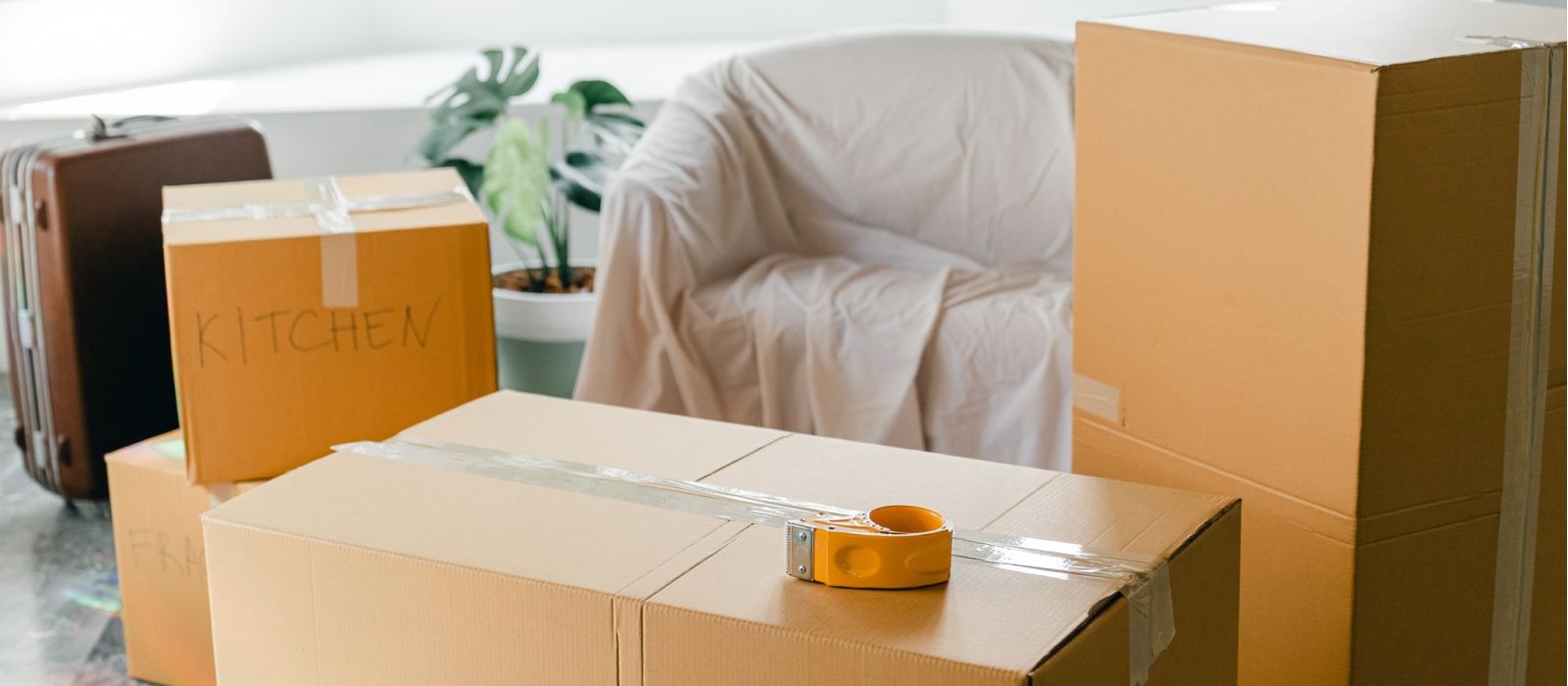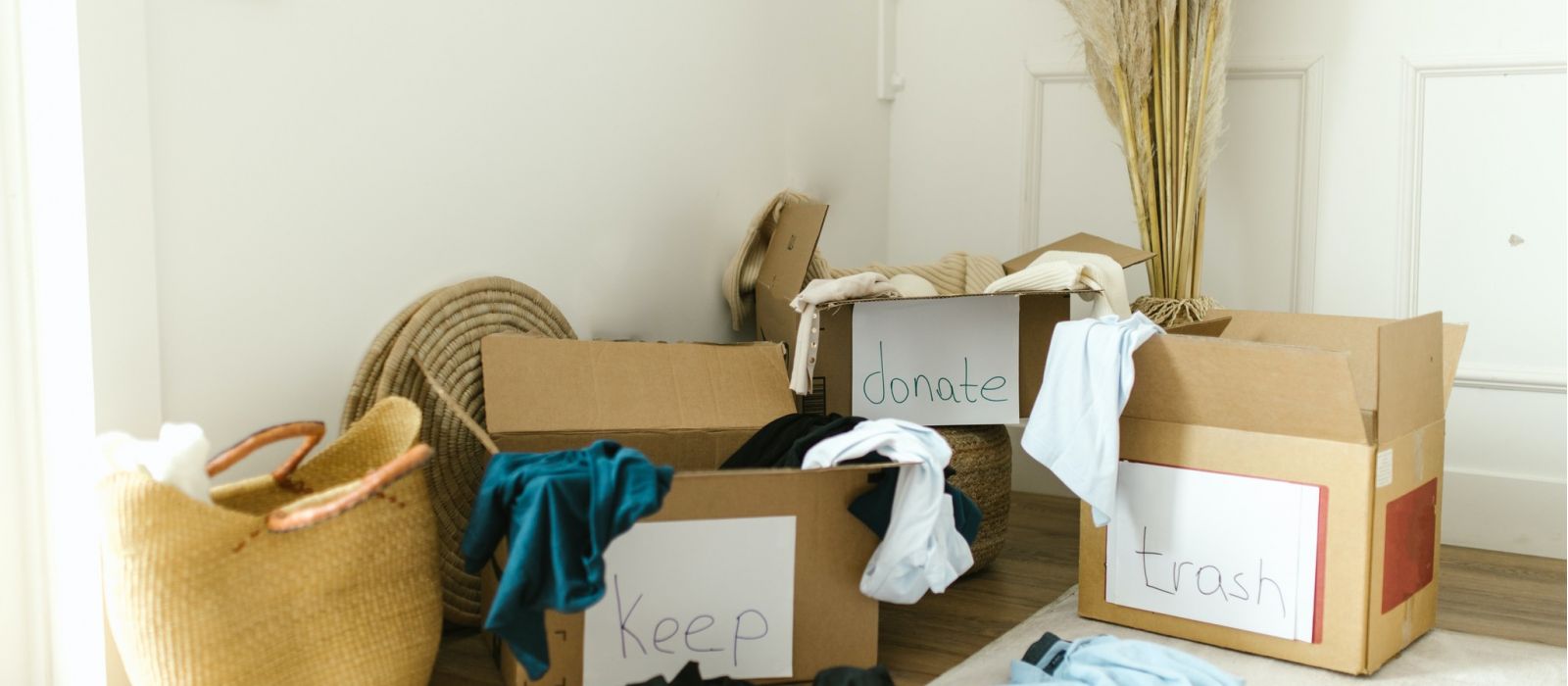Moving Forward
but it’s also a new beginning.

When you decide to move to a senior living community, you’re not just deciding to move to a new home. It’s so much more than that. You’re also embracing the opportunity to move to a new phase in your life, the chance to try new things and meet new people, and the option to age independently, on your own terms. It’s exciting and fulfilling. But it also can be scary and stressful. And frankly, a lot of work.
Logistically, there are boxes to pack, memories to preserve, heirlooms to bequeath, clothes to donate, addresses to change, utilities to shut off, movers to hire and a million other loose ends that have to be tied. Emotionally, there are comfortable routines that will be interrupted, certainties that might become uncertain, favorite places and possessions that will be displaced, goodbyes that must be said and fears that must be faced. And if you’re downsizing from a large and long-held family home? Both the logistics and the emotions of moving can be even more fraught.

None of it is easy. When you consider the life that’s waiting on the other side, however, it’s all worth it. The question, then, isn’t whether you should move to senior housing. If you’re planning your move, you’ve already done the work to cross that bridge. Instead, the question now is: How should you move to senior housing?
Although it can’t find someone to buy your old dining room table, move your bedroom set across town or hang a picture in your new place, this step-by-step guide can make your move just a little bit easier by helping you plan and prepare for the logistical and emotional challenges that await on your way to a new home—and more importantly, a new life.
When you consider the life that’s waiting on the other side, it’s all worth it.

1. Unpack Your Feelings
Moving can be physically exhausting, but also emotionally enervating. Long before you pack your things, you should therefore unpack your feelings. Doing so will give you the fortitude, motivation and resolve you need in order to turn the page to a new chapter in your life.
If you’re having a hard time coping with the prospect of change, or struggling with how to let go of people, places and possessions to which you’re attached, try to re-focus your attention from what you’re losing to what you’re gaining. For example, make a list of all the things you’re looking forward to in your new home. No matter what kind of retirement community you’re moving to—a community that offers independent living, assisted living, memory care or skilled nursing—there are reasons that you decided to move there in the first place.
Try to re-focus your attention from what you’re losing to what you’re gaining.

Perhaps you’ll be closer to your grandchildren. Maybe you’re excited about warmer weather, making new friends or trying new activities. It could be that you’re looking forward to having some extra help with activities that have become difficult, or that you’ll feel more comfortable in a home that’s safer for you. Whatever your motivations for moving, writing them down and keeping them in view during the moving process will help you maintain the positive, optimistic attitude you need in order to get through your transition successfully.
It also can be helpful to honor the life you’ve enjoyed in your current home. Hosting a going-away party with friends and family to share photos and memories can be a fulfilling and cathartic way to do so. Or consider inviting those same people to a housewarming party in your new home if it’s close by; knowing that your loved ones will still be in your life once you’ve moved can be a source of great comfort, and having a party on the calendar in advance of your move will give you something to look forward to at the end of a long process.
It also can be helpful to honor the life you’ve enjoyed in your current home.
If you’re still struggling to cope with your transition, a counselor or therapist might be able to help. Geriatric counselors who specialize in senior care can be especially helpful because they’re familiar with senior living communities and are well versed in the concerns that seniors have when they’re downsizing and moving to a new home. They can be an outlet for discussing things that you’re excited about and things you’re nervous about, and can offer useful strategies for coping with move-related guilt, regret, fear and anxiety, all of which are completely normal and usually a temporary side effect of change.

2. Sell Your Home, Not Your Memories
Of course, moving to a new home usually requires selling your old one. This is especially true for seniors who are moving to a senior living community, many of whom rely on real estate proceeds to finance the cost of living in a retirement community.
Emotionally and financially speaking, it’s in your best interest to sell your home as quickly as possible. If it’s allowed to sit on the market for too long, the listing will become stale, which ultimately will affect its sale price. Plus, a drawn-out sale will exacerbate any move-related anxiety that you’re already feeling.
To ensure your home sells as quickly as possible, for as much as possible, keep in mind the following advice:
Hire an agent who specializes in seniors.
Although you’ll have to pay a commission, a real estate agent typically is worth the money they charge because they have the knowledge, the network and the experience to successfully market your home, show it, negotiate with interested buyers and ultimately execute the transaction.
Agents who specialize in working with seniors are especially helpful because they understand the emotional aspects of selling a long-held family home; what financing options seniors have available to them; and the health, social and financial goals and constraints that are common to older adult clients. Plus, they’re educated about current scams targeting seniors, and how to protect their vulnerable clients from falling prey to them.
Although many agents might have experience working with senior clients, those who truly specialize in your cohort will typically have a Senior Real Estate Specialist (SRES) or Certified Senior Advisor (CSA) certification.

Prepare your home for sale.
Although your home is extremely personal, you should de-personalize it in order to appeal to buyers, who must be able to envision their family in the home instead of yours. That means removing personal photos and mementos, de-cluttering counters and surfaces, and moving or staging furniture in ways that might not work for your lifestyle but will emphasize for buyers the home’s best features and potential functionality. Your real estate agent can help and may suggest hiring a professional stager if reinforcements are necessary.
Be practical about pricing.
Your real estate agent will conduct a comprehensive and competitive market analysis in order to recommend a listing price for your home that’s based on its location, age, condition and other factors. The price might be more or less than you’d hoped for. While it’s important to protect your investment and maximize your return from it, be willing to look at the data and accept the reality of your local market. To the extent that you can, treating the sale as a financial instead of emotional transaction will allow you to get a good price in a short time frame so you can begin life in your new home soon and on the best possible footing.

If you find yourself feeling sentimental, keep in mind that selling your home doesn’t mean you have to erase it from your memory. You can move out and move on while still treasuring the life you had there. There are many ways to preserve and honor your memories in a home that you’re selling. If there’s a piece of the home that means something to you—for example, a door where you measured and marked your children’s height as they grew —you may be able to remove it and take it with you or pass it on to a family member. Or you could hire a professional photographer to photograph the home and make a framed print of it. Be creative and remember that you don’t have to live in the house in order to love the life that it gave you.

3. Downsize Your Possessions, Upsize Your Potential
Although some retirement communities offer large, spacious homes in which to enjoy independent living, it’s often the case that older adults who move to a senior living community do so because they want to live a simpler life in a smaller, more manageable space. If you’re one of them, moving likely will require you to pare down your possessions.
Doing so isn’t easy—especially if you’ve spent a lifetime accumulating and collecting art, books, clothing, jewelry, furniture, trinkets and countless other objects of functional and sentimental import. What can be extremely difficult, however, is also extremely important. Before you move into a new home, you have to make room physically and emotionally for the new life you want to live. When you do, you’ll likely feel freer, lighter and nimbler than you have in years, having shed pounds of literal and figurative weight that you were carrying in the form of your stuff.
You’ll likely feel freer, lighter and nimbler than you have in years, having shed pounds of literal and figurative weight that you were carrying in the form of your stuff.
But where to start? The following tips will help you simplify and streamline in no time at all.
Schedule “downsizing days.”
If you have a lot of downsizing to do, you need dedicated time for weeding through your things and sorting them. Scheduling that time in a structured manner—put a date on your calendar to sort through the kitchen, for example, and another date to sort through the basement—makes it easier to set tangible goals, and to hold yourself accountable for meeting them.
Do the math.
“Downsizing” is a vague concept. Bring some specificity to the situation by measuring your new home, or requesting a floor plan from the senior living community to which you’re moving. When you know square footage, number of closets and other important information, you can calibrate and calculate exactly how much downsizing you need to do.

Divide in order to conquer.
Dividing your possessions into different sorting piles—a pile to keep, a pile to sell, a pile to donate and a pile to throw away—is a favorite downsizing strategy that professional organizers use with their clients. You can physically sort smaller items into piles, or you can use colored stickers to mark items of all sizes so that professional movers can move them for you later. Keep in mind that there are myriad options for the items you want to sell and donate, including retail charities like Goodwill and Salvation Army, nonprofits that provide low-income families with used clothing and furniture, websites like eBay, social networks like Facebook Marketplace, garage sales, estate sales and even auction houses, if you own valuable collectibles or antiques.
Assess the amenities.
Keep in mind where you’re going and what services and amenities will be available to you. If there’s a fitness center in your new senior living community, for example, you can probably sell any home exercise equipment you might have. If there are housekeeping services, you can toss your cleaning supplies. And if you plan to eat all your meals in a community dining room or restaurant, then you may not need to bring all of your kitchen items with you.
Keep in mind where you’re going and what services and amenities will be available to you.
Get help.
Going through your things alone can be overwhelming and exhausting. Consider asking friends and family members for their assistance. This may be not only helpful—more hands makes for faster work—but also comforting in case you need emotional support to let go of certain items. Hired help also can be useful. A professional organizer, for example, can help you set priorities and offer useful strategies for accomplishing big jobs. There also are professional senior relocation services that specialize in helping older adults downsize their homes.
Hand down treasured items early.
If you have treasured items or family heirlooms that you plan to leave to your adult children or other relatives when you die, consider bequeathing them now instead. Doing so not only will free up space in your new home, but also will allow you to pass down something important to you while you’re still around to experience the joy that it creates.

4. Make Moving Day Manageable
No matter how much you plan and prepare, there’s just no getting around it: Moving day will be physically taxing and emotionally trying. But it also will be exceedingly exciting and gratifying. The more you can do ahead of time to mitigate the potential headaches, the more you’ll be able to savor the certain rewards. With that in mind, here are a few things you can do to make moving day go just a little bit smoother:
Start early.
The earlier you start planning your move—and packing your boxes—the better. Experts say two months prior to your anticipated move date is a good time to start planning. This should include getting estimates from moving companies and booking one of them, as the best movers often fill their slots weeks and even months in advance.
Get help.
Speaking of moving companies, you should hire one if you can afford it. Professional help will make things go more quickly and more smoothly. That said, it’s also good to have friends and family present to help, if possible. For example, consider appointing an adult child to the informal position of “moving day supervisor.” They can ease your burden by directing the movers and answering questions. Meanwhile, you can assign other helpers to various rooms of the house to do last-minute packing and cleaning.

Research move-in policies.
Your new senior living community may have special move-in policies of which you need to be aware on moving day. For example, where should you park your moving truck? Do you need a special permit? Is there a move-in fee? If you’re moving into an apartment or condominium in a multi-unit building, do you need to reserve a freight elevator? Finding all of this out ahead of time will ensure you don’t run into unwelcome surprises when you arrive to move into your new home.
Pack an overnight bag and a “first box.”
Anyone who’s moved before knows what it’s like to pack something you need and not know where to find it. Or worse yet, to know exactly where it is and be unable to reach it—because that place is in a box on a truck that’s still in transit. To prevent that common mistake from happening, pack an overnight bag to keep with you that includes essentials like a change of clothes, underwear, pajamas, an extra pair of shoes, medication and toiletries. Likewise, it’s a good idea to pack and label a “first box” that you will unpack before anything else in your new home. Inside should be things you need to make the first night and the first morning in your new home comfortable—for example, a nightlight, alarm clock, toilet paper, coffee maker and your favorite mug, etc.
Plan snacks and seating ahead of time.
If there’s anything you’ll need to conserve on moving day, it will be your energy. That means making time to eat and rest, even in the midst of your move’s busiest moments. But what happens when the fridge and cabinets have been emptied, and all the furniture has been loaded onto the truck? Think ahead to ensure you have an easy meal and snacks on hand, the means to eat them (e.g., paper plates, napkins, plastic cutlery) and somewhere other than the floor to sit when you need to take a break, like a folding chair or stool.
Think ahead to ensure you have an easy meal and snacks on hand, the means to eat them, and somewhere other than the floor to sit when you need to take a break, like a folding chair or stool.
Make arrangements for pets.
If you have a pet that you’ll be bringing with you to your new home, be sure to think in advance about how you’ll transport them in a way that’s safe and comfortable. You might need to invest in a new pet carrier, for example, or ask your vet about anti-anxiety measures. It’s also a good idea to pack a special box that you keep with you that contains their pet food, medicine and any favorite toys that will help them adjust to their new home. Finally, consider a pet relocation service, which for a fee will pick your pet up and transport them safely to your new home so you don’t have to keep an eye on them while you’re busy supervising the move.
Make time to say goodbye.
Don’t underestimate how emotional moving day might be. Before you load the final box and lock the front door, take a minute to appreciate your home and reflect on all the good memories you made there. It will be bittersweet, but you’ll be glad you gave yourself a moment of closure. Doing so will allow you to fully embrace your exciting new life in your new home.

5. Make Yourself at Home
and meeting new people.
Finally, the move is over. Now what? Although you probably won’t feel settled right away, rest assured: What feels new and foreign now eventually will feel as comfortable and familiar as a favorite chair. It just takes time.
What feels new and foreign now eventually will feel as comfortable and familiar as a favorite chair … it just takes time.
Still, there are things you can do to speed the process along and make your new space feel like home. Here are a few of them:
Unpack photos first.
If home is where the heart is, then the fastest way to make a home is to fill it with photographs of the people, places and memories that make your heart feel full.
Embrace the familiar.
A simple way to make a new space yours is to infuse it with things that remind you of your previous home. This might include not only favorite possessions—a piece of art or furniture from your old home, for example—but also favorite sights, sounds and scents. If you miss the rose bushes from the yard at your previous home, for example, buy some fresh roses and some rose-scented candles to burn. Or perhaps you used to live in the city and your new home is in a quiet suburb; buying a sound machine that plays traffic noises might be surprisingly soothing.
Let there be light.
You might experience moments of sadness or loneliness in your new home while you’re still adjusting to it. On days like that, make sure you open the blinds and turn on all your lamps. Making your home bright and light instead of dark and dreary can do wonders for your mood and your outlook.

Invest in houseplants.
You’ll meet new neighbors and make new friends, but that might take time. Meanwhile, houseplants can make good company. Not only do they provide fresh air, but they also will give you something to do and something to take care of.
Find your new favorite places.
Where did you spend most of your time before you moved? It’s important—and fun—to find equivalent places to frequent in your new community. If you spent a lot of time at church, for example, make it your mission to find a new congregation. If you had coffee every morning at a local restaurant, find a new favorite booth in a new favorite restaurant where you can spend your mornings getting caffeinated. And if you spent the first Tuesday of every month at the beauty shop, make it a priority to find a new place where you can get your hair and nails done.
More than anything else, it’s the people you meet who will make your new place feel like home.
Join a club or social group.
More than anything else, it’s the people you meet who will make your new place feel like home. It’s therefore important to seek out social groups and activities of which you can be a part. Fortunately, most senior living communities have plenty of them to offer. It could be a Bible study or book club, bridge group or bowling team. Find out what your community offers that interests you, then ask how you can get involved. Although being the new person can be intimidating, it’s important to get out of your comfort zone. New experiences and new relationships await.
Develop a routine.
A routine can give you a sense of normalcy while also helping you meet new people. Starting every morning with a walk around your new community, for example, will give structure to your day and help you meet your neighbors. If walking isn’t your thing, you could have dinner in the dining hall at the same time every evening, or attend the same yoga class every Wednesday afternoon. It could be anything. The key is to develop a routine that helps you establish a “new normal” in your new home.

New Home, New You
No matter your age or life stage, moving can be challenging physically, emotionally and socially. After all, it’s full of garbage bags and goodbyes. But the chaos and uncertainty that so often accompany a big move are temporary. What’s everlasting are the new opportunities it creates, the new relationships it facilitates and the new lifestyle it affords.
Wherever you are in the moving process—if you’re years away from moving to a senior living community or days—it’s important to keep those things in mind. The boxes eventually will be gone, and so will the anxiety. In their place will be a new home in which to make new memories. Although they can never replace your past, they promise at every opportunity to enrich your future. All you have to do is let them.
The boxes eventually will be gone, and so will the anxiety. In their place will be a new home in which to make new memories.
Navigate

